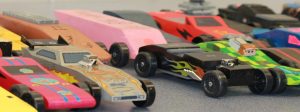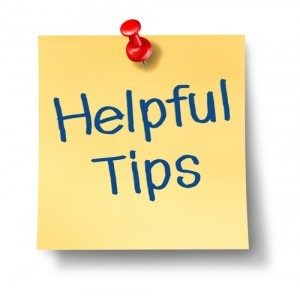INTENT –The purpose of this event is for the scout to build and race a wooden car. The scout should do as much of the work as is appropriate for his age. It is expected that a Tiger Cub will have quite a bit of help, but a Webelos 2 should be doing almost all of the work himself. Buying premade parts is not the goal of this event! Each scout is expected to build a new car each year.
THE KIT – The car shall be built from the official Cub Scout “Grand Prix Pinewood Derby Kit.” The Kit is a one piece wood block for the car body with plated nails for wheel axles and wide tread plastic wheels. Only official BSA wheels and axles may be used as replacements. Unofficial kits, bodies, wheels or axles will not be accepted. The “PineCar” or any other pre-cut bodies are prohibited from the District Race.
THE CAR BODY – You must start with the wood block provided in the kit and, as a minimum, the axle slots and some amount of continuous wood between the slots must remain from the original block. The axles should be inserted into the pre-cut grooves that are already cut in the car body. The wheel base (distance between the axles) must not be changed. You may add weights and other decorations if you wish. Decorative parts may be from any source.
WHEELS – All cars must have four official BSA wheels. The shape and form of the wheels must not be modified or reshaped. However, wheels may be cleaned up to remove molding burrs, but only a minimal amount of material may be removed.
- The embossed “tread” marks on the outer rim must still be visible.
- You may not remove material from the inside of the wheel.
- The molded lettering on the inside and outside of the wheel must be intact and visible to the judges.
- The wheels may be polished if desired.
- All four wheels must be in contact with a flat surface when the car is placed on it (i.e. all four wheels MUST turn when the car is rolled on a flat surface).
AXLES – The official kit provides nails for the axles, and you must use the official BSA axles. Wheel bearings, washers, bushings, axle sleeves, and wheel covers are prohibited. The axles may be smoothed and polished if desired. The axles may be glued or clamped to hold them in place in the slots.
PHYSICAL DIMENSIONS – Overall dimensions are: 3″ wide by 7″ long by 3″ high. Some kits come with blocks longer than 7″ and must be trimmed. Note that these rules allow a 3″ width vs. the 2 .” width specified in the kits. The width between the wheels must be greater than 1-3/4″, inside measurement. No part of the car can extend forward of the starting post.
TRACK CLEARANCE – Track clearance is specified at 3/8″ to clear the lane strips that are 1/4″ high.
WEIGHT – The car weight shall not exceed 5.000 ounces (141.75 grams). No loose material of any kind is permitted in or on the car. The car may be hollowed out and built up to the maximum weight by the addition of solid materials such as wood or metal provided it is securely attached or built into the body chassis. The weight MUST NOT be taped on. No liquid weights are permitted inside or attached to the outside of the car body. No weights may be added after the car has raced in the Pack race. Lead weights should be avoided due to the toxicity of lead. The premade metal weights, or steel, brass or tungsten should be used instead. If lead is used it must be under the surface, sealed from touch. Note that many low cost scales and most post office scales are not very accurate and your car may be overweight if you rely on them. At the district race, an official BSA 5 oz weight is used as the reference, and all cars must not weigh more than it does.
SPRINGS – The car shall not run on any type of springs. The car must be freewheeling with no starting devices.
LUBRICATION – The wheels and axles may be lubricated with any lubricant desired. However, a car that is dripping any oil or excessive amounts of graphite on the track will be disqualified. No additional lubricant may be added after the race starts. If wheel or axle repairs are necessary during the race, the replacement part may be lubricated under the supervision of a race official.
Registration Weigh-in and Inspection
- All cars must be registered, and inspected at the weigh-in in order to run in the race.
- NO EXCEPTIONS. Cars that are not registered and inspected at this time will not be allowed to race.
- Note that there will be no lubricants allowed at registration.
Only the First and Second place cars for Tiger Cubs and the First and Second place cars for Cub Scouts / Webelos Scouts from the Pack race will be allowed to register for the district race (or a Third place alternate if either of the first two cars are disqualified, for example if it is built from an unofficial car kit or has unofficial wheels). A Pack Race Official is required to impound the cars at the completion of the Pack Race and bring them to the registration and inspection. This is to prevent any modification to the cars between the Pack and District races. The car drivers and their parents should be at the registration and inspection in case the car does not meet the physical dimension requirements or is too heavy and weight must be removed. To minimize any issues with weight we suggest adding weights in a manner that allow easy adjustment, addition or removal.
- Carefully trim all flash from the sides, hubs, and contact surfaces of the wheels. Remember that you cannot change the profile (shape) of the wheel.
- Remove the sharp edges on the axel nails by first filing, then placing in the chuck of a drill and using sand paper to make smooth. After you can use pumice, or polishing compound to polish the axles. Pay special attention to the heads of the nails that will contact the outside hub of the wheel.
- When mounting the wheels leave between 1/16th and 1/8th inch of play (total) on the axle. This prevents binding and makes it easier to lubricate the wheels.
- Make sure that the car rolls straight when placed on a level surface and that all four wheels touch the ground; adjust the axle nails as needed.
- After the axles are perfect, use two-part epoxy or hot glue gun to set the axles in position. The BSA axle clamps may also be used.


